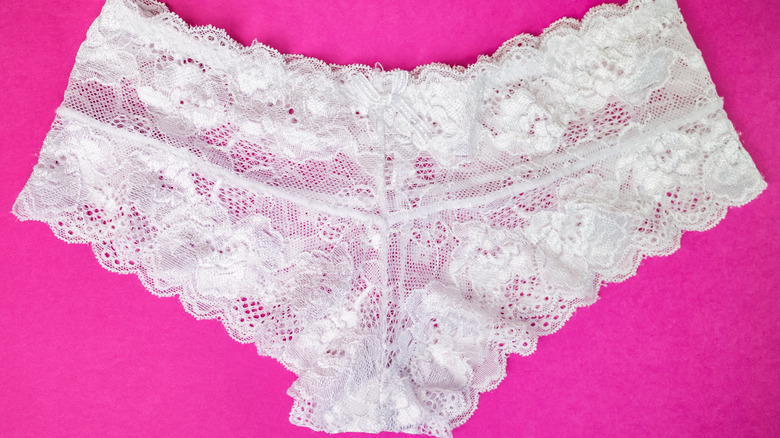The Real Reason Women's Underwear Has A Pocket
Women's fashion can be weird. While many ladies know the curse of having trouble finding a dress with pockets, it seems like every pair of underwear has one. What is that little pocket in the crotch of your panties for? Surely it's not meant to replace pockets on other layers of clothing, right? It's not even big enough to fit much, and let's not get into the logistics of how uncomfortable it would be to sit if you actually stored something in there. So what's the deal?
First off, the pocket isn't meant to be used for storage. It's not for decoration or extra protection in the event of a wardrobe malfunction, either. That pocket in the crotch of women's underwear actually has a name: the gusset. Gussets are super important and were designed to protect your lady parts, which we all can agree is a good thing.
Here's what gussets are designed to do
Women's underwear is often made of synthetic materials like lace. While lace might look sexy, it also doesn't breathe very well, which means that bacteria and sweat can build up more easily and get trapped in your underwear. Not fun. Gussets are typically made from cotton — a breathable, non-synthetic fabric — and help keep things dry and ventilated down there. Not only does the gusset make things more hygienic, but that little bit of extra fabric also cuts down your risk of uncomfortable conditions like yeast infections and urinary tract infections by making your panties more breathable.
Gussets serve another function, too. Since synthetic materials aren't always the most comfortable — think of how scratchy bare lace can feel on sensitive skin — gussets provide a soft, cozy place for your lady bits to rest upon, protecting them from friction.
Even if your fancy, synthetic-material panties come with a gusset, though, your best bet is still plain old cotton undies. While that little patch covered by the gusset might help, overall breathability is still important.
Breathability is even more important if you're active throughout the day. If you think there's any chance you're going to be sweating, skip the synthetic materials. This means if you're going for a run or hitting up the gym, you need to be wearing cotton unless you want to risk inflammation or an infection. This is especially true if you're prone to bacterial problems down there. Cotton panties may not seem as sexy as lacy Victoria's Secret lingerie, but they're a lot more comfortable than a yeast infection.
Is your underwear (or lack thereof) actually safe?
If you've learned all of this and still don't want to wear cotton underwear, there are some non-cotton options that are better than others. "Panties made of things like polyester, nylon, Lycra or Spandex sometimes have more stretch and lay nicer under clothing and still come with that cotton crotch," Dr. Melissa Piliang told Health.
Watch out for thongs, though. While they don't pose too much of a threat if you're healthy and not prone to infections, for some people thongs are a quick way to spread bacteria. "If you have a little bacteria — E. coli is the most common bacteria in the colon — in the back part of the fabric and you're physically active, that material may move," Dr. Jill M. Rabin told HuffPost. "All it has to do is move an inch or two and it's next to the vagina or urethra. That thong may be depositing colonic bacteria into your vagina or urethra."
Additionally, wearing a thong while on your period can increase the risk of infection even more, as menstrual fluid raises the pH fluids in your vagina, making it easier for bacteria grow. Thongs can also irritate the sensitive skin in your nether regions and exacerbate hemorrhoids.
What about going commando? Not wearing underwear is not only totally safe but may also be beneficial — at least overnight. "I recommend my patients sleep without underwear to give their vulvar skin a break from constant coverage — this helps reduce chronic inflammation," Dr. Suzanna Chatterjee told Oprah. "If you do wear underwear to sleep, find a pair with full coverage to avoid overnight irritation."
It should also go without saying that you should change your underwear every day. If you're recycling your panties without washing them, that bacteria and sweat is going to build up whether your underwear has a pocket or not.



